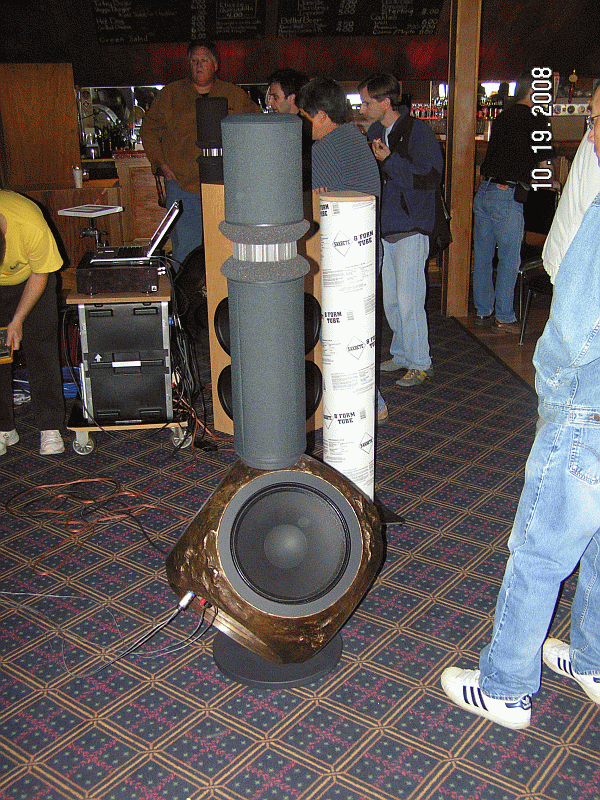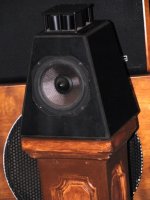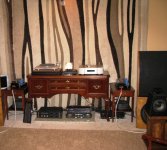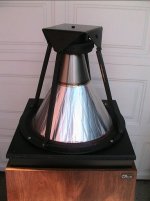Is it omni?

no, I don't think its omnipolar
more like multi bipole
think of what we do know happens with side by side mounted drivers 😉
What was the question again?
Oh yeah... I don't know the answer.
I have spent some time listening to dipoles (Quads) and omnis. The first omnis I heard were part of a cheap integrated "stereo system" my father bought back in the '70's. Zenith? Squat little boxes with upward-firing drivers with a sort of "disperser" (I guess they would call it a "lens" now) to spread the sound out. Driven from an integrated amp/turntable unit. Not pretty. They sounded better than they had any right to.
Last year I built a pair of Linkwitz Plutos. They kick ***. I continue to have "Pluto moments" where I am startled by them. It's true they are not really omnis, but they are omni where it matters, and they do a lot of other things right.
Oh yeah... I don't know the answer.
I have spent some time listening to dipoles (Quads) and omnis. The first omnis I heard were part of a cheap integrated "stereo system" my father bought back in the '70's. Zenith? Squat little boxes with upward-firing drivers with a sort of "disperser" (I guess they would call it a "lens" now) to spread the sound out. Driven from an integrated amp/turntable unit. Not pretty. They sounded better than they had any right to.
Last year I built a pair of Linkwitz Plutos. They kick ***. I continue to have "Pluto moments" where I am startled by them. It's true they are not really omnis, but they are omni where it matters, and they do a lot of other things right.
The first omnis I heard were part of a cheap integrated "stereo system" my father bought back in the '70's. Zenith?
Electrohome.
dave
Last year I built a pair of Linkwitz Plutos. They kick ***. I continue to have "Pluto moments" where I am startled by them. It's true they are not really omnis, but they are omni where it matters, and they do a lot of other things right.
Yeah. Any plumber would be proud of Doppler effect they produce! 😛
This past weekend I listened to an updated version of the Linaeum tweeters on a High Emotion Audio Pyra Bell 7 Pyra Bella 7 - Products - High Emotion Audio with a Peavey 18 inch Black Widow bass units crossed over at 80Hz and bi-amplified. A very nice speaker and I can only hope that some day the tweeter will be available to DIY......😀😀😀
Attachments
Why are OMNI speakers not more popular?
Short & simple answer: because by nature, an omni directional speaker significantly increases the ratio of reflected to direct radiation, so you are listening more to, and therefore are more at the mercy of, the room and its acoustics.
yes, very, I mean very well said! 😀 definitely godlike is the right word!
AudioPro has a model following Carlsson design principles:
http://www.audiopro.se/media.php?id_file=527
typical flooder, short, everything up-firing
I am a tad confused by this
Reading this article (and going off the pictures) I am lead to believe that normal speakers only fire forwards and dont ever reflect off nearby walls or the back wall, or the floor, and will never fill the room with moving particles of air
(this is actually true, my speaker is to my right and no matter how loud I put it I can only hear it when I'm stood infront of it) </sarcasm>
But if you fire them upwards they suddenly start producing sound in all directions, which then reflect off everything.
My point is this sounds like utter marketing rubbish to me. The speaker is firing at the ceiling (and will reflect off it) just as a normal floor stander fires at the back wall (and then reflects off it)
Yes they are tilted slightly, but then so are normal speakers, they rarely fire directly at the back wall and will be tilted inwards slightly (except for mine, I do have mine parallel to the walls)
I am a tad confused by this
(...)
The speaker is firing at the ceiling (and will reflect off it) just as a normal floor stander fires at the back wall (and then reflects off it)
are You sure? just as? yeah, looks You are confused
Short & simple answer: because by nature, an omni directional speaker significantly increases the ratio of reflected to direct radiation, so you are listening more to, and therefore are more at the mercy of, the room and its acoustics.
not really, or at least - it depends, anyway, it certainly doesn't apply to a flooder, by it's nature 😉
have You read this?
http://www.diyaudio.com/forums/mult...-speakers-not-more-popular-3.html#post2594162
They were popular in Sweden, the whole Carlsson line was omnidirectional.
Personally I've built a clone of a speaker inspired by the Carlsson line, the pop box. That speaker solves the tweeter directonality problem by having multiple tweeters like this:
An externally hosted image should be here but it was not working when we last tested it.
Sound imaging is godlike compared to ordinary directional speakers, I will never be able to go back them... next project is to try to make a true omnidirectional open baffle speaker by placing a tweeter ring both on the front and at the back of the baffle =)
// Olle
That thing reminds me of a Bose 301. Maybe the 301 would have made a better speaker than coffee table had they spent more than 87 cents on the tweeters.
I've always thought that Omni was an interesting idea, but to go along with it, wouldn't you need recording equipment designed to capture it properly?
not really, or at least - it depends, anyway, it certainly doesn't apply to a flooder, by it's nature 😉
have You read this?
http://www.diyaudio.com/forums/mult...-speakers-not-more-popular-3.html#post2594162
I've no idea what 'this' is supposed to be, other than a link to the thread we are currently on. By definition, an omnidirectional speaker will increase the ratio of reflected to direct radiation (unless you happen to listen to loudspeakers in an anechoic chamber, or in the middle of a field).
Last edited:
tb46 said:The Ohm A with the Walsh driver from the early 70s comes to mind as a true full range omnidirectional loudspeaker.
Which in turn reminds me of the modern approach: German Physiks - High End Technology Loudspeaker Manufactur - DDD Driver - Home
Regards
Last edited:
I've no idea what 'this' is supposed to be, other than a link to the thread we are currently on.
invalid link? in that case let me quote:
btw, its funny tho that my experiment clearly showed that floor positioned drivers had great and precise imaging/soundstage
and even more funny that singers etc were positioned with the correct height
and that with all sorts of things placed around
furniture, boxes, project, etc
far from optimal
placed close to walls
and below a big bookshelf
probably couldn't be worse
but it still worked
so
By definition, an omnidirectional speaker will increase the ratio of reflected to direct radiation (unless you happen to listen to loudspeakers in an anechoic chamber, or in the middle of a field).
yes, it will, surely - but we don't know the effect of this from psychoacoustical point of view, the after therefore part of Your statement is not necessarily correct:
Short & simple answer: because by nature, an omni directional speaker significantly increases the ratio of reflected to direct radiation, so you are listening more to, and therefore are more at the mercy of, the room and its acoustics.
short & simple it is, cannot deny
Sigh. As I have stated, an omnidirectional speaker in a room significantly increases the ratio of reflected to direct radiation. By definition, this means the end results are more heavily dependant upon the acoustic environment, and its absorbitions, reflections etc. than a conventional loudspeaker. If you are unable to grasp this basic point, there is no possibility of logical discourse on the matter.
Last edited:
Hi Y'all,
The Ohm A with the Walsh driver from the early 70s comes to mind as a true full range omnidirectional loudspeaker.
Regards,
Well, not quite. Not omnidirectional in the vertical, only in the horizontal, like most.
Member
Joined 2009
The perfect speaker is a small point source dispersing sound equally into all directions.
OMNI designs are not very popular because many of them don't meet those requirements very well. Many small bookshelf type speakers with a 4" woofer and a 1" tweeter come close to being omni sources and are also very popular.
OMNI designs are not very popular because many of them don't meet those requirements very well. Many small bookshelf type speakers with a 4" woofer and a 1" tweeter come close to being omni sources and are also very popular.
Sigh. As I have stated, an omnidirectional speaker in a room significantly increases the ratio of reflected to direct radiation. By definition, this means the end results are more heavily dependant upon the acoustic environment, and its absorbitions, reflections etc. than a conventional loudspeaker. If you are unable to grasp this basic point, there is no possibility of logical discourse on the matter.
yes indeed, if one is unable to grasp the basic point, there is no possibility of logical discourse
but back to the topic- again I think Your statements are not necessarily correct -> what kind of acoustic environment have You got in Your mind?
truth is that in a typical listening acoustic environment that is a typical living room omni - especially a flooder type - is much less dependant than a conventional loudspeaker and actually that is quite easy to explain why, and the key is exactly the increase of the ratio of reflected to direct sound, paradoxical? I say - think about it and then sigh 😉
So you believe that different room sizes, shapes, and contents with their different levels of reflection and absorbtion have no affect whatsoever upon the sound.
Oh dear. I was right. No logical discourse is possible, so colour me done.
Oh dear. I was right. No logical discourse is possible, so colour me done.
Last edited:
The perfect speaker is a small point source dispersing sound equally into all directions.
Only if it is used in conjunction with the perfect microphone that captures sound equally in all directions.
Say we could make a microphone like that, where each microscopic point on a sphere shaped device captured a perfect point-source of what arrived at it. What would the wiring look like on such a beast? There would literally be half a million or more wires coming out of it, each one labelled and identifiable, so that it could go into it's equally mythical recording device.
A tape? It would be dozens of meters wide. A digital unit? Terabytes per second.
Until we have figured out a way to to capture it properly, all we're doing is sending the same signal that we've captured with a few strategically placed microphones and then trying to play it back through a speaker that just sprays sound out in directions that we never actually recorded a proper input from and then expecting it to be a truthful reproduction with accurate time and space.
It might be a neat effect, spraying sound waves around our rooms with oddly placed drivers and bouncing them off of every surface. I bet it's impressive, but we can't really convince ourselves that it's an accurate reproduction of what was really going on at the recording venue, can we?
- Home
- Loudspeakers
- Multi-Way
- Why are OMNI speakers not more popular?


